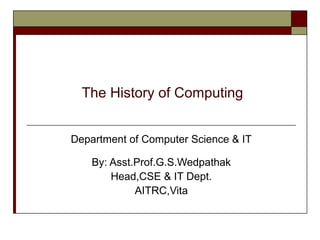
History of computing by g.s.wedpathak
- 1. The History of Computing Department of Computer Science & IT By: Asst.Prof.G.S.Wedpathak Head,CSE & IT Dept. AITRC,Vita
- 2. 2 TAKE ROLL!
- 3. 3 Unofficial Field Trip IBM 1401 computer system, fully restored and operational A small transistor-based mainframe computer. Extremely popular with small businesses in the late 1950s through the mid 1960s Maximum of 16K bytes of memory. 800 card/minute card reader (wire brushes). 600 line/minute line printer (impact). 6 magnetic tape drives, no disk drives.
- 4. 4 Unofficial Field Trip, cont’d Babbage Difference Engine, fully operational Hand-cranked mechanical computer. Computed polynomial functions. Designed by Charles Babbage in the early to mid 1800s. Arguably the world’s first computer scientist, lived 1791-1871. He wasn’t able to build it because he lost his funding. His plans survived and this working model was built. Includes a working printer! http://www.computerhistory.org/babbage/
- 5. 5 Unofficial Field Trip, cont’d The new Revolution exhibit is now open! Walk through a timeline of the First 2000 Years of Computing History. Historic computer systems, data processing equipment, and other artifacts. Small theatre presentations. Atanasoff-Berry Computer Hollerith Census Machine
- 6. 6 Unofficial Field Trip, cont’d Study the exhibits. Think of project ideas.
- 7. 7 What was the IBM 1401? A “small scale” computer system developed by IBM in the late 1950s. 1401 CPU1402 Card Read Punch 1403 Line Printer729 Tape Drive1407 Console
- 8. 8 What was Computing Like Before the 1401? Business data processing involved applications that manipulated data records: Inventory Billing and receivables Payroll
- 9. SJSU Dept. of Computer Science Fall 2011: August 24 CS 185C: This History of Computing © R. Mak 9 What was Computing Like Before the 1401? Data was stored in punched cards called “IBM cards” or “Hollerith cards” Named after Herman Hollerith. 80 columns per card, one character per column. Up to 12 punched holes per column. Alphanumeric data, often grouped into fields.
- 10. 10 Punched Cards Punched cards used the Hollerith code. Rows 0-9 were numeric punches The topmost row was row 12 and the second row was 11. Rows 12, 11, and 0 were zone punches. Examples: Char Punch 3 3 A 12-1 M 11-4 S 0-2 $ 11-3-8
- 11. 11 What was Computing Like Before the 1401? A data processing application involved passing decks of punched cards through electromechanical “unit record” machines. Repetitive sort, calculate, collate, and tabulate operations ... ... were programmed with hand-wired plugboard control panels.
- 12. 12 Plugboard Control Panel IBM 407 Accounting Machine (1949)
- 14. 14 Programming a Plugboard “Hmm, should I pass this parameter by value or by reference?” “Programming” was hand-wiring plugboards.
- 15. 15 Programming a Plugboard Plugboard wiring diagram It doesn’t look too complicated, does it?
- 16. 16 Data Processing Data processing was all about punched cards. My compiler project: 3½ boxes of punched cards Each box = 2000 cards, 10 lbs.
- 18. 18 Data Processing Cards were punched manually at a keypunch machine. Or they were punched automatically by unit-record equipment under program control.
- 19. 19 Data Processing Cards were re-keyed on a verifier to ensure accuracy. Good cards were notched at the top right edge. Bad cards were notched at the top edge above each erroneous column.
- 20. 20 Data Processing A sorter sorted cards one column at a time. You had to run decks of cards multiple times through a sorter. Accounting machines performed arithmetic on card fields and printed reports.
- 21. SJSU Dept. of Computer Science Fall 2011: August 24 CS 185C: This History of Computing © R. Mak 21 Data Processing Reproducers made copies of card decks. Tabulators were accounting machines: simple arithmetic plus printing. Interpreters read cards and printed information on the cards.
- 22. 22 Data Processing Gang punching: Automatically punch multiple cards from the contents of a single card.
- 23. 23 Data Processing A collator compared and merged decks of punched cards.
- 24. 24 Running a Data Processing Application ... ... meant passing decks of cards through a sequence of unit-record machines. Each machine was programmed via its plugboard to perform its task for the application. Each machine had little or no memory. The punched cards stored the data records The data records moved as the cards moved. An entire work culture evolved around punched cards!
- 25. 25 How did the IBM 1401 change all that?
- 26. 26 IBM 1401 Innovations One of IBM’s first all-transistor computers. Earlier machines used vacuum tubes. Used magnetic core memory instead of a plugboard. A new instruction set. An inexpensive stored-program computer.
